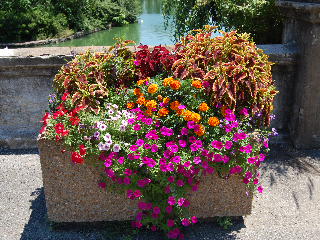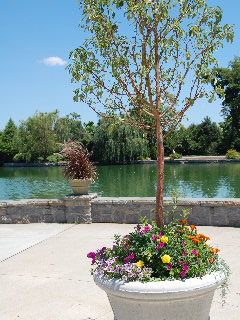
If variety is the spice of life, then unexpected combinations of plant materials can be the key to stirring a unique flavor into your flower garden.
As we use the expression “flower garden,” let’s remember that we are talking about any planting or grouping of plants in the same area, whether they are growing in an outdoor garden setting or in containers.
And if “variety” is the goal in our creative gardening exercise, what elements are we able to work with in order to achieve this goal; in other words, what can we vary? Four elements come to mind: color, texture, growth habit (form), and height of the growing materials. Let’s take a look at each of these.
Color is probably the easiest thing to work with in order to create variety in our flower garden. Not only do we have an almost infinite number of bloom colors and color combinations to choose from, but we can even select combinations of plants with varying shades of foliage coloration, from yellowish-greens to deep lustrous greens to reds and purples.
Following closely behind color, and closely related to it in terms of seeking plant variations, is texture of the plant material. By texture, we actually mean the appearance we perceive as the light bounces off the plants; do they look glossy, soft, velvety, dense, smooth, coarse, fissured or wrinkled?
Form comes into play next in our quest for variety and unpredictability in putting our flower garden together. By form, we mean the density of the individual plants if we were to view each plant by itself; does the plant appear dense, producing a lot of leaves or a lot of side shoots and stems that are held closely together not allowing much light to penetrate across the individual plant? Or is the growth habit of the plant more open with fewer leaves and stems, thus permitting more light penetration?

Height is the fourth variable we’ll look at as we consider ways to add desirable contrasts into our flowerbeds. How much variety can we incorporate into our planting by using plants of different heights? Just about as much as we want to! Small plants, tall plants, plants as flat as a shoe; tiny plants, mighty plants, Dr. Seuss was a gardener, too! And, if you really want to take it to the extreme in choosing plants of different heights, why not incorporate a small tree or two into your flower garden? Maybe a small Japanese maple or a low-growing buckeye tree or a dwarf flowering ornamental of some sort? Be bold!
Let’s look at a quick example of how a planting might appear if we “mix-up” some of these elements we’re talking about. How about some petunias of different colors around the outside edges of our flower container? As they develop, the petunia plants will take on a flowing growth habit, trailing down over the outside of the container. Ivy would also assume this flowing growth habit and would provide a color and texture difference with its shiny, dark green leaves. Closer in to the center of the plant container, we can add some marigolds (which provide different texture, colors, tighter blooms, and a little more height). Next, we’ll add coleus for differing shades of green, yellow, and red foliage. The coleus leaves also add a coarse texture to our mix and the plants themselves will grow rather tall (in excess of 18”) if they are not pinched back, in which case they will assume a shorter denser bushier growth habit.
A “mono-culture” planting of all pansies or all impatiens or all petunias or all anything of the same color results in a very pretty flowerbed, but it also tends to be a bit boring and all too expected. So, why not be a little bolder and create an attractive and unpredictable flower planting by varying the elements we’ve talked about: color, texture, form, and height. Grab your trowel, select an array of plant material, and mix it up!
 If variety is the spice of life, then unexpected combinations of plant materials can be the key to stirring a unique flavor into your flower garden.
If variety is the spice of life, then unexpected combinations of plant materials can be the key to stirring a unique flavor into your flower garden.
 Height is the fourth variable we’ll look at as we consider ways to add desirable contrasts into our flowerbeds. How much variety can we incorporate into our planting by using plants of different heights? Just about as much as we want to! Small plants, tall plants, plants as flat as a shoe; tiny plants, mighty plants, Dr. Seuss was a gardener, too! And, if you really want to take it to the extreme in choosing plants of different heights, why not incorporate a small tree or two into your flower garden? Maybe a small Japanese maple or a low-growing buckeye tree or a dwarf flowering ornamental of some sort? Be bold!
Height is the fourth variable we’ll look at as we consider ways to add desirable contrasts into our flowerbeds. How much variety can we incorporate into our planting by using plants of different heights? Just about as much as we want to! Small plants, tall plants, plants as flat as a shoe; tiny plants, mighty plants, Dr. Seuss was a gardener, too! And, if you really want to take it to the extreme in choosing plants of different heights, why not incorporate a small tree or two into your flower garden? Maybe a small Japanese maple or a low-growing buckeye tree or a dwarf flowering ornamental of some sort? Be bold!